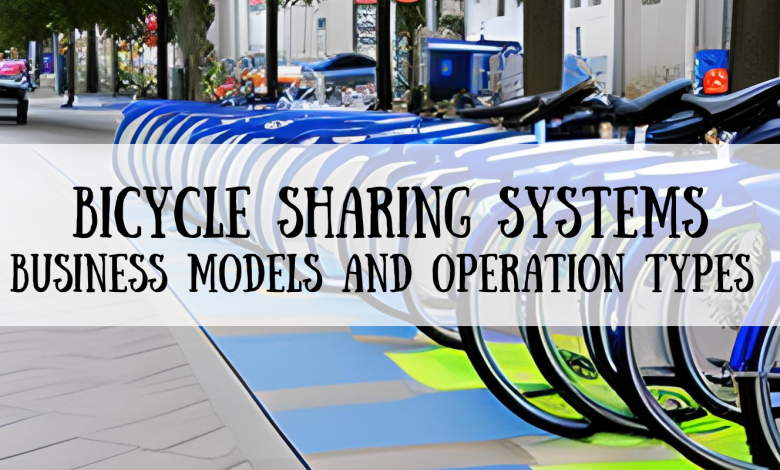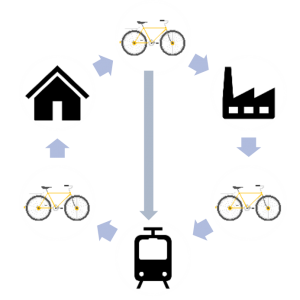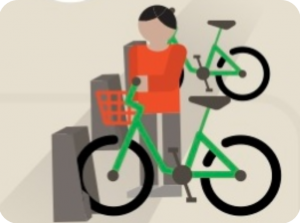
[spotifyplaybutton play=”https://open.spotify.com/track/3u9fHuAtjMY1RW2mZfO4Cf?si=e477680804d94404″]
INTRODUCTION
İSBİKE smart bike sharing systems, which have been serving throughout Istanbul since 2013, have reached more than 118 thousand subscribers with 2503 bicycles serving at 281 stations, and over 426 thousand rentals have been made, according to the data in the first 7 months of 2021. With 146 stations on the European side and 135 stations on the Anatolian side, İSBİKE, which has the widest bike rental network in Turkey, is said to have given bicycle use and awareness training to approximately 3500 citizens in the bicycle school activities carried out to spread the bicycle culture to the society and to make the people of Istanbul get the habit of using bicycles.
It is seen that many different business models are proposed for bike sharing around the world with the participation of public-private sector and non-governmental organizations. (Table 1)
Table 1 Bike Sharing Business Models (Winslow & Mont, 2019)
SUPPLIER |
BUSINESS MODEL |
INCOME FLOW |
ADVERTISING COMPANIES |
Establishment of bicycle sharing systems-stations by outdoor advertising and street furniture manufacturers in return for the use of advertising spaces. The use of bicycles as advertising space. | Advertising revenues, bicycle usage fees. |
PUBLIC TRANSPORT AGENCIES |
Public authorities and local public transport agencies provide system installations to complement the public transport network. | Public support, usage fees, advertising revenues from bicycles and stations. |
LOCAL GOVERNMENT |
Systems designed and operated directly by local governments or their contractor. | Usage fees, advertising revenue from bikes and stations, parking fees, sponsorships |
FOR-PROFIT ORGANIZATIONS |
Systems established and operated by private enterprises with minimal support from local governments. | Usage fees, sponsorships, advertising revenues, |
NON-PROFIT ORGANIZATIONS |
Systems established with the support of public administration or agencies operating under the public. | Public-private financing, usage fees, bank loans, local funding grants |
Velo’v firm, private sector supplier and private sector operator in Lyon, France, Velo Yelo, public supplier and public operator in La Rochelle, MOL Bubi, public supplier and private sector operator in Budapest, and Public supplier and public operator in China Guangzhou Public Bikes companies are an example of alternative bike sharing system business finance models. Table 1 presents some bike sharing systems and operator types in use around the world. (Table 2)
Table 2 Bicycle Sharing Systems Worldwide
CITY |
COUNTRY |
SYSTEM NAME |
OPERATOR |
| Buenos Aires | Argentina | Mejor en Bici | Public |
| Brussels | Belgium | Villo! | Special |
| Rio de Janeiro | Brazil | Bike Rio | Special |
| Montreal | Canada | Bixi | Public |
| Toronto | Canada | Bixi Toronto | Special |
| Guangzhou | Chinese | Guangzhou Public Bicycle | Public |
| Lyon | France | Vélo’v | Special |
| Washington | USA | Capital Bikeshare | Special |
| Miami | USA | DecoBike | Special |
Aims / Benefits of Bicycle Sharing System
The use of bicycle, which can be seen as the longest-lasting micro-mobility vehicles and the ancestor of micro-mobility with its current name, brings many advantages for the environment and people, offers solutions to some social problems and opens a door for sustainable transportation. The fact that it is a flexible and versatile means of transportation, its sales costs are very low compared to other types of transportation and its usage costs are almost non-existent compared to other types of transportation, has carried the use of bicycles as a means of transportation rather than a sport in geographies suitable for bicycle transportation. Bicycles, which have the potential to make a significant contribution to reducing traffic congestion, dependency on fossil fuels and emission values, should be supported by local governments and the safe usage network should be expanded.
Bicycle sharing systems are seen as an important step in solving problems such as bicycle ownership and safe storage. The location of sharing systems in such locations, especially for bicycles, which can be considered as an “intermediate mode of transportation” in accessing systems with high passenger carrying capacity such as rail systems, will make the bicycle one of the biggest supporters of public transportation in order to provide sustainable transportation. .
When the bike sharing systems around the world are examined, 43% of the members using the Denver B-Cycle system started to travel by bicycle instead of a car (Denver B-Cycle, 2010). reduced congestion by 5% (Bremner, C., Tourres, M., 2008), 400 new jobs were created thanks to the Bixi system in Montreal (Bixi, 2010), 23% of Nice Ride system users in Minneapolis had previously driven by car. There are many examples such as the city of Lyon, where the bicycle system was opened for operation (Nice Ride, 2010), and the use of bicycles increased by 44% in the first year when the bicycle system was put into operation (Buhrmann, S., 2008). This shows us that the use of bicycles will still be an effective choice for human needs and transportation when the appropriate infrastructure and system are provided.
Before You Start Planning
In order to start planning a bike sharing system in a region, some priority issues need to be considered and evaluated. It will be vital for the next steps to determine the primary and secondary goals of the system, to reduce the dependency on existing transportation vehicles such as cars and buses, to reduce the need for parking spaces, to prevent the occupation of abandoned bicycles, and to plan it within this scope for the efficient use of the system. .
In order to determine the system requirements, it is necessary to target how many people the service will appeal to, to evaluate in which geographical region and within the scope of what area, to determine the membership types and user profile types by considering the frequency and length of bicycle use, and to determine the need for bicycles at this stage. Another issue will be to determine what the current capacities and opportunities are. In this context, it is necessary to determine the number of sufficient personnel and the trainings that these personnel will need to operate and support the system in the current situation. Along with the workforce, studies should be carried out at this stage regarding the system infrastructure for bicycle stations and parking areas and the adequacy of the existing infrastructure to meet their needs.
After evaluating all the scope and possibilities, it is necessary to decide which financial resources will be used for the installation and operation of the needed system, whether public or private, to evaluate the methods such as sponsorship to support the system financially, and to determine how the operating costs and system improvements and renewals will be financed.
Bicycle Sharing System
Business and Business Models
Ad Hoc Systems: In these systems, bicycles are left unlocked at certain points. Bicycles are painted or marked a specific color to show that they are communal. Everyone can buy and use the bikes as they want. The advantages of this system are that it is the lowest cost bike sharing model since there is no technological infrastructure and operating costs, and users can use the bike model they want. Disadvantages are that no data can be kept on how much bicycles are used and by whom, that it is difficult to find a bicycle where you need it because it is left in random areas, bicycles can be easily stolen, damaged, open to dangers and security weaknesses.
Bike Garages (Bike Corral): Bikes are stored and locked in a central location. The keys of the locks are located and managed by a person in a central place. In this system, bicycles have to be picked up and left from the bicycle garages during operating hours. While there are advantages such as relatively low investment costs, the use of the desired bicycle model optional, and controllability with the central management, there are costs such as space allocation, personnel requirement, and the necessity of picking up and leaving the bicycles from a certain point causes the lack of flexibility and responsiveness.
Electronic Key Boxes: It is a system in which bicycle keys are secured by using electronic key boxes and records are kept about bicycle use. In these systems, which do not require specially designed bicycle stations and stops, switch boxes can be mounted right next to the bicycles on the bicycle parking bar. Since there is an integrated U-lock on the bikes, this system provides ease of use as the user can lock the bike to the parking bar that he wants, and bike sharing management is seen as the lowest cost system since there is no balancing service between stations. However, due to the fact that users have to pick up bikes from certain places and leave them in the same places, in the system, which is seen as low in flexibility,
Kiosk – Station Based Systems: These are the systems that are installed as stations and kiosks in certain regions and controlled electronically by locking the bicycles. In this system, the safety of the bicycles is very high and can be accessed 24/7, the kiosk points determine where the system is, and it is possible to determine how much bicycles are used and where they are thanks to the software. The system, which is the most expensive solution in terms of initial setup and operating costs, requires specially designed and electronically equipped bicycles, and system flexibility is low as bicycles can only be left at stations.
Station-Independent (Free Floating) Systems:Since station-based bike sharing systems do not offer a very flexible bike delivery option, station-independent (Free Float) systems have started to become widespread since 2017. Since there are no stops and parking units in station-independent systems, system infrastructure requirements and investment costs are considerably reduced. However, since all system operations are carried out via IoT devices on the bike, bike costs increase. The biggest advantage of station-independent bicycle systems is the flexible solution it brings to the transportation problem, which is called the last kilometer (Last Mile). A more flexible transportation alternative is offered as users can go to the last point they want to reach.
Prerequisites for the Bike Sharing System
-
Station Density
A successful bike sharing system needs 10-16 stations within 1 km2 . The distance between these stations should be around 300 meters, which is the appropriate walking distance. Lower frequency of stations or too long distance between stops reduce usage rates.
- Quantity
Although it may vary according to population density, there should be at least 10-30 bicycles per 1000 people in areas where the bicycle sharing system is located, and the number of bicycles in the system must be higher in order to meet the demands during peak hours, especially in metropolitan cities.
- Range
Since low coverage areas will reduce the use of the system, the area where the bike sharing system is installed and covered must be at least 10 km2 in order to reach a sufficient number of users and transportation points .
Bicycles should be designed to be sturdy, useful and pleasing to the eye. The bike must have a specially designed model and parts to avoid theft and bike parts being sold elsewhere . The locking system of the bicycles is fully automatic and all bicycle and user movements should be monitored in real time. The process of renting a bike should be easy. The user interface of the software should be arranged in an easy, fast and understandable way for payment and registration to the system.
Bicycle Sharing System Features
Bicycle, station and parking units and information technology infrastructure constitute the three main elements of today’s bike sharing systems. Considering the researches and user feedback, the requirements and suggestions regarding these three main elements stand out as follows.
Bicycles included in the bike sharing system should be resistant to climate conditions, have a stylish and simple design, appeal to unisex use, be resistant to vandalism and be robust. In terms of ease of use and functionality, it is recommended to use a bicycle with at least 3 gears and a basket.
Sustainability of stations and parking units, 24/7 bike rental and delivery, easy rental with subscriber and bank cards, working with solar energy panels, modular and portable structure, bike helmet rental, and service to balance the bike distribution between stations. and the expected issues in terms of customer satisfaction.
In information technology infrastructure, information such as simultaneous monitoring of bicycle access over the internet via computer or mobile applications, tracking of bicycle movements by the authorities, and the usage history of each bicycle should be accessible to the authorities. At the same time, it is expected that functions such as membership, rental start-end and payment will be offered to users over the internet and mobile applications.
Advantages and Disadvantages by Business Models
Public institutions and organizations have the authority to use all materials for the bike sharing system to be successful, there is no other purpose for the system to work successfully. However, the specialized knowledge on the operation of bike sharing systems is insufficient in general.
Public transportation departments have knowledge and experience in transportation services. It has the opportunity to reduce and share costs as it has customer service, maintenance personnel and storage areas. However, it is difficult to cooperate with institutions working on other transportation services as they have the potential to see each other as competitors. The bike-sharing system could evolve into its own customer service, maintenance and storage center as it grows.
The private sector generally seeks to achieve high productivity. Since it works profit-oriented, obstacles may arise in the development of the system for the benefit of the user. Efficiency may decrease due to financial bottleneck or contractual terms; It is difficult for the administration to adapt to new programs and policies.
Non-profit organizations primarily aim to make the bike sharing system efficient and convenient for the user. In general, its financial strength is weak and limited. Its financial sustainability power is insufficient as its focus on business is below average .
Determining the Business Model
In order to determine the business model, a number of considerations must be determined. As we mentioned at the beginning, first of all, the targets aimed with the bike sharing system should be determined correctly. Health, creating an alternative mode of transportation, reducing traffic congestion, reducing air pollution, striving to be a more livable city, increasing the use of bicycles, making short-distance journeys with bicycles instead of vehicles, the main demand expressed by non-governmental organizations on every platform is to make bicycle a means of transportation. Taking these benefits into consideration within the scope of targets, taking into account many benefits such as the integration with public transportation, joint planning and projects with the metro – metrobus – Iett,
Within the scope of these objectives, considering the installation, operation and maintenance costs and system expectations, the owner who will undertake the investment costs of the system and the operator who will carry out the maintenance and repair activities should be determined from among public, private or non-profit organizations. In the next stage, the initial installation cost of the system and how the operating expenses will be met should be determined, in this context; Alternatives such as State Incentives and Funds, Own Resources, Resource Allocation from the public budget, joint fund creation, sponsorship activities, build-operate-transfer model should be evaluated.
What is Required for the Effective and Efficient Operation of the Bicycle Sharing System?
In order to ensure the effective and efficient operation of the bike sharing system, the usage purposes should be expanded and the needs of the user groups and technological developments should be taken into consideration. In this context; bicycles should be comfortable and safe, there should be rental stations at many points and easily accessible, subscription and rental processes should be easy and understandable, bicycles should be easily taken from the station, safe bicycle paths should be made, tariffs to encourage bicycle use should be applied, transfer discounts should be included in transfer discounts within the scope of integration with public transportation. It should be a good advertising, promotion and customer service center, the web page should be clear, short and understandable, the mobile application should be designed so that everyone can use it, and it should be in a structure that can be used by foreign tourists.
In addition, in order to raise awareness of the system and its social benefits, joint studies should be carried out with Non-Governmental Organizations, their opinions and suggestions on the system and operation should be sought, and NGOs should act with NGOs to provide the necessary infrastructures to make the use of bicycles and other micro-mobility vehicles safe and secure. It can be ensured that central and local administrations put these issues on the priority agenda.
Conclusion
With its many features such as human health, environmental awareness and creating an alternative solution to the traffic problem, it is accepted worldwide that the dissemination of bicycle transportation and micro-mobility solutions is a necessity to ensure sustainable transportation, and it is an undoubted reality. From the determination of the targeted benefits, it is a necessity that the expansion of micro mobility networks should be included in the transportation emergency action plans by planning the most effective and sustainable business model and user and business-oriented system details. To meet the needs of individuals, If bicycle transportation, which will become a preferable transportation system with the increase in usage network and safe usage opportunities, cannot be expanded, sufficient benefits will not be gained and the sustainability of the system with low gains will be endangered. In order to expand the use in this area, especially in metropolitan cities, it is necessary to accelerate the continuity of the studies started in order to make the bicycle sharing systems widespread, to ensure that the systems that have an important place in sports and entertainment and human life are seen as a part of transportation.
We would like to thank Ahmet Savaş , Chief of İSPARK Heliport and Smart Bicycle Operations, for his valuable contributions and support .
Sources;
https://www.itdp.org/ “Institute fot Transportation & Development Policy”
Winslow, J., & Mont, O. (2019). Bicycle sharing: Sustainable value creation and institutionalisation strat-egies in Barcelona. Sustainability, 11(3), 728.






